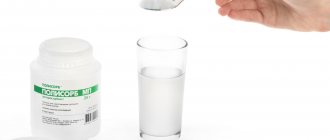Product benefits
Siberian fiber has the following beneficial properties:
- Normalization of blood sugar levels.
- Cleansing and improving bowel function.
- The product removes toxins and waste from the body, cleansing it.
- Reducing blood cholesterol.
- Saturation of the body with vitamins and nutrients.
- Appetite disappears, hunger decreases.
- The fat layer is reduced.
- Hormonal levels are normalized.
- Urolithiasis is prevented.
What it is?
Fiber is the plant fiber that makes up the leaves and stems of greenery, the peel of vegetables and fruits, and the shell of grains and seeds. They are not digested in the stomach, but play a very important role in maintaining health. Why does the body need fiber, what are its beneficial functions?
Turboslim Active fibers, 60 g, Evalar
475 ₽
Dietary supplement NOT A MEDICINE
- Helps cleanse the intestines
and relieve constipation. - Serves as a breeding ground for microflora
. - Helps
and blood sugar levels - Helps reduce the risk of colon cancer
.
What foods are high in fiber? In bran - 40-45 g per 100 g, flax seeds - 25-30 g, whole grain cereals - 10-15 g, legumes - 9-13 g, wholemeal bread - 8-9 g. In almost all fruits it contained in amounts from 1.5 to 3 g. In beets and onions - 3 g, in carrots and white cabbage - 2-2.4 g.
Is it possible to lose weight with it?
With the help of Siberian fiber you can really lose weight. It leads to a decrease in appetite, normalizes the functioning of the digestive tract, and cleanses the intestines. Harmful substances are removed from the body. Weight loss is carried out gradually; in a week of using this product you can lose from 3 to 5 kilograms .
If you consume Siberian fiber for too long, you may experience flatulence, so you should not consume this product for more than two weeks. It is necessary to take a break of one month. Siberian fiber promotes weight loss and at the same time fills the body with vitamins and nutrients.
Hypoallergenic diet for nursing mothers: sample menu, list of permitted and prohibited foods.
Find out from this article how a child should eat with high acetone. Advice from Dr. Komarovsky and other doctors.
Possible harm and contraindications
Despite the effectiveness and beneficial properties of the product, there are a number of contraindications that you need to familiarize yourself with:
- Gastritis.
- Colitis.
- Low blood pressure.
- Individual intolerance to the product.
- Cholelithiasis.
- Cholecystitis.
- Pregnancy.
- Lactation period.
This product causes harm if there are contraindications or if used for too long. It is not recommended to consume Siberian fiber for more than two weeks . The negative impact of the product appears in the form of side effects:
- Hives.
- Diarrhea.
- Nausea.
- Vomit.
- Stomach ache.
- Weakness.
- Paleness of the skin.
Unsolved problems and new opportunities in the treatment of chronic constipation
Constipation, or constipation (Latin constipatio), is a chronic intestinal dysfunction characterized by longer than normal intervals between bowel movements, difficulty defecating, insufficient bowel movements and hardening of the stool. The term “constipation” (constipation, obstipation) is understood as a persistent or intermittent dysfunction of bowel movement; constipation syndrome is an integral complex of various, usually subjective, symptoms associated with disruption of the bowel movement process [1]. Until recently, it was believed that chronic constipation (CC) affects, on average, about 12% of the adult population worldwide [2, 3]. According to some data, today in the UK alone more than 50% of the population considers themselves to be constipated; in Germany the number is 30% and in France it is around 20%. In Russia, according to one study, 34.3% of the population complains of constipation, and 16.5% meet the Rome III criteria (2006) [4].
Currently, according to the literature, as well as in practical healthcare, the presence of constipation is still determined according to the standards proposed by A. M. Connell et al. - the frequency of bowel movements is from 3 times a day to 3 times a week, that is, the presence of constipation is recorded when defecating less than three times a week [5]. However, only the rarity of bowel movements cannot be a universal and sufficient criterion for the presence of constipation: the presence of incomplete bowel emptying, difficulties during bowel movements with scant excretion, as a rule, of solid and fragmented “sheep” type intestinal contents must be taken into account. More than half of patients with chronic disease may experience the need for intense and prolonged, and sometimes fruitless, straining, a feeling of incomplete bowel movement, and unpleasant and sometimes painful sensations during bowel movements. Moreover, it is complaints about the need for prolonged straining and ineffective defecation that are the most indicative and reliable signs of constipation (sensitivity 94%) [6].
In a survey of 1149 people, 27.2% reported constipation and 14.9% met the Rome III criteria (2006) for chronic disease. The frequency in women is approximately 2 times higher than in men. At the same time, the symptom of rare stools is not the most common and is approximately half as common as straining (Fig. 1) [7].
The Rome Consensus III (2006) on the problems of functional gastrointestinal diseases included the following symptoms in the definition of chronic disease:
- less than 3 bowel movements per week;
- separation of feces of high density;
- lack of feeling of complete bowel movement after bowel movement;
- presence of a feeling of blockage of contents in the rectum during pushing;
- the need for strong pushing;
- the need for digital removal of contents from the rectum, support of the pelvic floor with fingers, etc.
In the International Classification of Diseases, 10th revision, constipation occupies a separate position - K 59.0.
To understand the mechanisms of disease development and the reasons for the sometimes low effectiveness of therapy, it is necessary to characterize some physiological mechanisms that ensure the normal functioning of the gastrointestinal tract (GIT) and its motor activity. Firstly, this is the presence of contents in the intestine, which, in quantity and quality, is a physiological irritant for peristalsis. There are also a number of other mechanisms: a) the presence of an undisturbed muscular system, external and intrinsic innervation of the intestines; b) preservation of endocrine and paracrine regulation; c) the presence of a normal reflex from the rectum and unimpaired function of the pelvic floor muscles; d) absence of obstacles to peristalsis [8].
Disturbances in the system that ensures normal intestinal motor function can lead to the formation of chronic disease, since any type of constipation is based on one or another type of colonic motility disorder - dyskinesia, which plays a leading role in its pathogenesis. It should be noted that both hypomotor and hypermotor dyskinesia (the latter is even 20–25% more common) can lead to chronic disease. In addition, the normal functioning of the rectum, anal sphincter, pelvic floor muscles, and abdominal wall is important in the mechanism of bowel movement. It is known that defecation is a voluntary and suppressed act, depending not only on purely biological components, but also on social conditions. Disruption of the rhythm of bowel movements, suppression of unconditioned (gastrocolytic, orthostatic) physiological reflexes leads to an increase in the sensitivity threshold, accumulation of feces in the rectum, and disruption of its propulsive function. It is characteristic that with this type of constipation, disturbances in the motor function of other parts of the colon, as a rule, are not detected [9].
Coordination of the activity of the pelvic floor muscles is also important. In the presence of dysfunction of the puborectal muscles and (or) the external sphincter of the rectum, defecation disorder may also appear, expressed in a feeling of incomplete emptying of the rectum. This type of constipation is also called “muscular” [5].
In addition, there are functional and organic (mechanical) constipation, intestinal and extraintestinal obstipations, constipation with normal and enlarged colon sizes, primary, secondary, idiopathic, constipation, divided according to the topographic principle, in accordance with the “functional units” of the colon [ 5, 10].
With idiopathic constipation, the most thorough examination does not allow us to establish the cause of constipation. The idiopathic form of chronic disease is accompanied by pathological changes in the neuromuscular apparatus of the colon, a decrease in its propulsive activity, stimulated by food intake [8].
Patients with hypochondriacal somatoform personality disorders are characterized by mental changes, expressed in the patient's fixation on intestinal activity, in exorbitant demands placed on bowel regularity. Patients often torture themselves with various kinds of manipulations in order to more completely empty the intestines, abuse enemas, laxatives, and disrupt the normal reflex of emptying the rectum. Stool retention, usually manifested after a bowel movement with a laxative or an enema, psychologically traumatizes patients, forcing them to take additional doses of laxatives, which can result in persistent diarrhea syndrome (the intestine loses the ability to absorb water), loss of fluid, electrolytes, especially potassium. A “vicious circle” is created, further aggravating the constipation syndrome with pronounced general phenomena, including dehydration, hypokalemic paralysis, and an increase in residual nitrogen in the blood.
Increasingly, irritable bowel syndrome (IBS) is becoming the main cause of constipation. Under conditions of neuro-emotional overload, stress, especially chronic stress, the activity of the central and autonomic nervous systems is disrupted, which leads to an imbalance of catecholamines, biogenic kinins, intestinal hormones (motilin), endogenous opioids and entails dysregulation of intestinal activity, mainly its motility (primary dyskinesia of the colon) [5].
A change in the sensitivity threshold of visceral receptors, which determine the motor-evacuation function of the intestine, is also of certain importance. A major role in the development of chronic disease against the background of IBS is played by disturbances in diet and bowel movements, as well as the nature of nutrition. Among the features of the clinical picture of constipation that developed against the background of IBS, it is necessary first of all to note the pain syndrome that is relieved after defecation, a small volume of stool, its fragmentation like a “sheep’s stool,” and the release of a large amount of mucus [11].
Treatment of patients with chronic constipation
Treatment of chronic disease requires significant effort, first of all, from the patient himself. Only with strict implementation of all recommendations is it possible to really achieve the corresponding effect. The beginning of treatment for chronic disease is a change in eating behavior and nutritional structure. It is necessary to increase the content of ballast substances in the diet and introduce foods that stimulate the motor activity of the large intestine (table).
A prerequisite for the success of chronic disease therapy is the consumption of more fluid, which is necessary to improve the effect of dietary fiber and other ballast substances. For prolonged constipation or in case of ineffective diet therapy, dietary fiber, wheat bran or flax seeds, Plantago ovata are prescribed. Bread made from premium flour, baked goods, fatty meats, smoked meats, canned food, spicy foods, chocolate, strong coffee, and strong tea are excluded from the diet. The consumption of porridges made from semolina, rice, vermicelli, and potatoes is limited. Products that cause increased gas formation (legumes, cabbage, sorrel, spinach, apple and grape juices) are not recommended. Foods rich in essential oils (radish, turnip, onion, garlic, radish) are excluded from the diet.
In cases where lifestyle and diet changes are not effective, laxatives are usually the next treatment option. Despite the widespread use of laxatives, reliable, evidence-based information assessing their benefit to patients is lacking [12]. According to the World Organization of Gastroenterology, only polyethylene glycol (PEG) from the group of laxatives has a high level of evidence (level of recommendation I and level of evidence A) [13]. Traditional laxatives work for many, but not all, patients and are inappropriate for some patients due to side effects, unpleasant taste, or use [14].
Laxatives are divided into separate groups depending on their mechanism of action:
1. Drugs that increase the volume of intestinal contents [12].
Psyllium (psyllium husk), methylcellulose.
They retain water in the intestinal contents, soften the consistency of stool, increase stool volume and enhance motility.
The onset of action is observed 12–72 hours after administration.
Used as an initial remedy, daily use and use during pregnancy are possible.
Adverse effects: bloating, flatulence, abdominal pain, mechanical obstruction due to insufficient fluid intake, impaired absorption of calcium and iron.
Difficulties in use: the need to take large volumes of liquid, delayed and unpredictability of the effect, the need for preparation [15].
2. Stool softeners [12].
Mineral and other oils.
They act mainly as surfactants. Increases the water content in stool, softening it.
The onset of action is observed 6–8 hours after administration.
Minimal role in the treatment of constipation in outpatient settings.
Adverse effects: cramping abdominal pain, electrolyte disturbances.
Contraindicated in patients with acute intestinal obstruction or suspected cases.
3. Osmotic agents [12].
Salts (magnesium sulfate, etc.), sugars (lactulose, etc.), polyethylene glycol.
Retains water in the intestinal lumen using an osmotic gradient.
The onset of action for lactulose and PEG is observed 24–48 hours after administration. For salt products - after 0.5–3 hours.
PEG and lactulose can be used during pregnancy.
Lactulose provides limited relief for constipation, and most comparative data indicate that it is less effective than PEG [14].
Adverse effects: salt agents - electrolyte disturbances, polyethylene glycol: abdominal bloating, diarrhea, sugar - electrolyte disturbances, bloating, diarrhea, abdominal cramps, for lactulose, loss of effect is possible with delayed transit due to destruction by bacteria [14].
Difficulties in use: unpleasant taste, delayed and unpredictable effect [16].
4. Stimulants [12].
Diphenylmethane derivatives (bisacodyl, picosulfates), anthraquinones (senna, etc.).
They reduce the absorption of water and electrolytes and increase their secretion into the intestinal lumen, and also stimulate the myenteric nerve plexuses of the colon [14].
The onset of action for bisacodyl is observed after 6-10 hours, for senna - after 6-12 hours.
Bisacodyl and senna are used to treat occasional (not chronic) constipation.
Adverse effects: electrolyte disturbances, intestinal melanosis (anthraquinones), dehydration, potential for abuse, abdominal discomfort and pain [14].
Difficulty in use: addiction [16].
Virtually all stimulants cause short-term, and with long-term use, permanent secretory diarrhea, leading to excessive fluid loss and electrolyte disturbances, primarily hypokalemia. Potassium ions, along with other mechanisms, maintain the tone of intestinal smooth muscles, so a decrease in the concentration of potassium in the blood inevitably leads to smooth muscle relaxation and increased constipation if it is caused by hypotonicity of the intestinal wall. Disruption of fluid homeostasis contributes to the development of secondary hyperaldosteronism, which, in turn, is also accompanied by potassium loss, and the vicious circle closes. This is one of the main mechanisms of addiction and increased constipation with long-term use of all secretory laxatives [15].
Treatment with laxatives often does not eliminate all symptoms of constipation. For example, an international study including 13,879 people in 7 countries found that taking laxatives did not reduce the frequency of symptoms compared with patients who did not take them (Fig. 2) [17].
The degree of deterioration in quality of life with constipation is comparable to patients with gastroesophageal reflux, hypertension, diabetes and depression [18]. Thus, in a study of 557 patients with chronic disease according to the Rome III criteria, more than half of respondents reported that constipation somewhat, significantly, or extremely affected their quality of life.
The majority of respondents reported that constipation extremely, significantly, or somewhat affected their daily activities [19]. Patients were taking a variety of prescription and over-the-counter laxatives, and about half were dissatisfied with the treatment, mainly due to lack of effectiveness. Even more patients are dissatisfied due to low predictability of effect, ineffectiveness in treating associated symptoms, and ineffective relief of bloating [19].
Among the most important properties of the drug in the treatment of constipation, patients indicated the effective elimination of symptoms (straining, hard, infrequent stools), improvement in the quality of bowel movements, tolerability, predictability, elimination of associated symptoms, the possibility of long-term use and elimination of bloating. Drugs that meet at least several of these properties will play a significant role in the treatment of constipation [19].
More recently, the published results of a large survey of 1355 patients with chronic disease in 10 European countries showed that only 28% of patients taking laxatives were satisfied with this treatment. There was no association between satisfaction and types of laxatives. In addition, when asked about their interest in other treatments, 89% of patients dissatisfied with laxative therapy responded in the affirmative. Interestingly, even among patients who were satisfied with laxatives, 72% said they were interested in other treatments [20].
Several new pharmacological classes other than laxatives have been studied in patients with constipation. These include opioid receptor antagonists, neurotrophins, chloride channel activators, guanylate cyclase C activators, and serotonergic enterokinetics [14]. Of these, only the representative of serotonergic enterokinetics, prucalopride, is approved for use in the Russian Federation.
It is known that motility is regulated due to two types of innervation of the gastrointestinal tract: external and internal.
External innervation is carried out by the sympathetic and parasympathetic nervous systems, which have an antagonistic effect on gastrointestinal motility. The sympathetic nervous system causes relaxation of the gastrointestinal tract muscles, while the parasympathetic nervous system causes its contraction.
Internal innervation is represented by intramural (autonomous and intercalary) neurons, united in the submucosal and muscular plexuses. The muscular plexus (Auerbachian) contains neurons that can have a stimulating and inhibitory effect on the muscle fiber. Thanks to the presence of intramural neurons in the muscular plexus, gastrointestinal motility can be regulated autonomously when the sympathetic and parasympathetic systems are completely turned off.
Internal innervation is provided by the action of intramural neurotransmitters. Classic mediators are:
- acetylcholine for cholinergic neurons;
- serotonin for serotonergic neurons;
- ATP for purinergic neurons (the purinergic system has an inhibitory effect on the tone of smooth muscle fibers).
New mediators include neuropeptides:
- a vasoactive interstitial peptide that can activate and inhibit muscle neurons;
- somatostatin, which can inhibit and stimulate intramural neurons;
- substance P, which excites intramural neurons;
- enkephalins that modulate the activity of intramural neurons.
Increased motor activity is observed when parasympathetic (through acetylcholine), dopamine and serotonin receptors are stimulated, and weakening is observed when the sympathetic nervous system is stimulated.
Serotonin is an indolethylamine formed in biological systems from the amino acid L-tryptophan. It, like histamine, is found in plants, animal tissues, poisons, and secretions. Once synthesized, the free amine is either stored in cells and tissues or quickly inactivated by oxidation catalyzed by the enzyme monoamine oxidase. In humans, more than 90% of the serotonin in the body is found in the enterochromaffin cells of the gastrointestinal tract.
Serotonin has many different effects on intestinal function and has major influences on sensitivity, secretion and motility [21].
To date, 14 types of serotonin (5-HT) receptors have been described. The greatest amount of information related to the functions of the gastrointestinal tract in normal and pathological conditions has been accumulated regarding 5-HT3 and 5-HT4 receptors [21, 22].
5-HT4 receptors (serotonin receptors of the 5-HT4 type) enhance peristalsis, causing a combined contraction of the intestine proximal to its contents and relaxation, respectively, distally. This is achieved through the regulation of the release of other neurotransmitters (excitatory and inhibitory) directly involved in gastrointestinal motility (acetylcholine, etc.) [21].
Serotonergic enterokinetics stimulate 5-HT4 receptors, enhancing the peristaltic reflex, demonstrating effectiveness in the treatment of chronic disease.
Prucalopride is the first highly selective 5-HT4 receptor agonist, whose affinity for these receptors is at least 200 times higher than for others [14].
The drug was evaluated in three randomized, placebo-controlled, double-blind studies with identical designs. They included 1924 patients with a long (on average 20 years) history of constipation and failure of previous therapy in the majority [23]. During the 12-week study period, in the group receiving prucalopride 2 mg/day, 23.6% of patients achieved normal bowel movements (≥ 3 complete voluntary bowel movements per week), and 73% had a clinically significant effect - an increase of ≥ 1 voluntary bowel movements per week [24].
In addition, in these studies, when assessing the effect of the drug on the symptoms of constipation, it was found that prucalopride, compared with placebo, significantly reduces stool hardness, straining, the feeling of incomplete emptying, etc., as well as associated abdominal pain, discomfort and bloating [25] .
The most common adverse events with prucalopride were headache, nausea, diarrhea and abdominal pain. In most cases, these effects were mild to moderate. The rate of treatment discontinuation due to adverse events was 5.9% in the prucalopride 2 mg group and 3.6% in the placebo group. Additionally, most of these side effects were temporary. When assessed over the 12 weeks of the study, excluding the first day, their incidence in the prucalopride 2 mg group did not differ from the placebo group [26].
In open-label observation, which included patients from clinical trials, the drug was taken for up to 2.5 years. During this time, the level of satisfaction with therapy was maintained at a consistently high level [27].
Considering the high prevalence of constipation among the elderly (up to 50%), it is important that prucalopride in special studies was effective in this group of patients [28].
Currently, prucalopride is included in the recommendations for the treatment of chronic diseases of the World Gastroenterological Organization (level of recommendation I and level of evidence A) [13], the National Institute for Clinical Excellence (NICE) of Great Britain [29], as well as in treatment regimens for constipation gastroenterologists in Europe [30] and Canada [31].
The practical experience accumulated to date by the authors confirms the effectiveness of prucalopride in eliminating the symptoms of constipation and its good tolerability in patients with varying duration and severity of the disease.
Treatment of patients with chronic disease should be based on their own assessment of symptoms and the impact of these symptoms on quality of life.
For successful therapy, it is necessary to clarify the patient's expectations from the measures taken. Setting realistic goals leads to satisfaction with treatment and leads to better outcomes. Does the patient expect complete resolution of symptoms? Does he or she want to avoid adverse events? Perhaps the goal is simply to lead a normal life without being tied to the toilet? Treatment options should be assessed with the patient, including expected improvement in symptoms and possible side effects.
Although constipation is often perceived as simply infrequent bowel movements, it is in fact a symptom complex that varies in duration and intensity from one patient to another, requiring an individualized treatment approach.
For many reasons, patients are often dissatisfied with the symptom relief achieved through traditional treatment approaches such as fiber and laxatives. As a result, there is a significant need for drugs that address the various symptoms of constipation. Fortunately, the number of effective, well-tolerated treatments is growing. New and developing drugs to treat constipation will likely fill treatment gaps for many patients, especially those who experience symptoms on an ongoing basis.
The presented data suggest that the arsenal of practicing physicians for the treatment of patients with chronic disease has been significantly enriched with a new enterokinetic agent - prucalopride. Its most important advantages include the persistence of the clinical effect, lack of addiction, and a minimal number of adverse events.
Literature
- Samsonov A. A. Chronic constipation syndrome // Russian Medical Journal. 2009. No. 5. P. 10–14.
- Gastroenterology. Directory. Ed. A. Yu. Baranovsky. SPb: Peter. 2011. 512 p. pp. 94–95.
- Dietetics. Management. 2nd ed. Ed. A. Yu. Baranovsky. St. Petersburg: Peter. 2006. 960 p. pp. 521–526.
- Lazebnik L. B. Prevalence and risk factors of constipation in the adult population of Moscow (according to the population study “MUZA”, Experimental and Clinical Gastroenterology). 2011. No. 3. P. 68–73.
- Maev I.V. Chronic constipation // Gastroenterology. Proctology. 2007. No. 7. pp. 16–20.
- Loranskaya I. D. Constipation - new solutions to an old problem // Russian Medical Journal. 2007. T. 9, No. 1. P. 1–3.
- Pare P. et al. An Epidemiological Survey of Constipation in Canada: Definitions, Rates, Demographics, and Predictors of Health Care Seeking // The American journal of gastroenterology. 2001, vol. 96, no. 11.
- Shemerovsky K. A. Chronophysiology and chronopathology of digestion // Donosology. 2007. No. 1. P. 44–54.
- Shulpekova Yu. O., Ivashkin V. T. Pathogenesis and treatment of constipation // Russian Medical Journal. 2004. T. 6, No. 1. P. 3–7.
- Shulpekova Yu. O. Algorithm for the treatment of constipation of various origins // Russian Medical Journal. 2007. T. 15, No. 15. P. 1–7.
- Gastroenterology. National Guide: Brief Edition. Ed. V. T. Ivashkina, T. L. Lapina. M.: GEOTAR-Media, 2011. 480 p. pp. 126–127.
- Jennifer Drost, Lucinda A. Harris. Diagnosis and management of chronic constipation // JAAPA. 2006, v. 19, no. 11.
- World Gastroenterology Organization Global Guidelines, Constipation: a global perspective. 2010, november.
- Tack J., Muller-Lissner S. Treatment of Chronic Constipation: Current Pharmacologic Approaches and Future Directions // Clinical gastroenterology and hepatology. 2009; 7:502–508
- Belousova E. A. Rules for choosing laxatives: the niche of stimulant laxatives in the treatment of constipation // Farmateka. 2011, no. 15, p. 47–52.
- Muller-Lissner S. The difficult patient with constipation // Best Pract Res Clin Gastroenterol. 2007; 21(3):473–484.
- Wald A. et al. A multinational survey of prevalence and patterns of laxative use among adults with self-defined constipation // Aliment Pharmacol Ther. 28, 917–930.
- Wald A., Sigurdsson L. Quality of life in children and adults with constipation // Best Practice & Research Clinical Gastroenterology. 2011, 25, 19–27.
- Johanson JF, Kralstein J. Chronic constipation: a survey of the patient perspective // Aliment Pharmacol Ther. 2007; 25:599–608.
- Muller-Lissner S., Tack J. et al. Levels of satisfaction with current chronic constipation treatment options in Europe — an internet survey // Aliment Pharmacol Ther. 2013; 37: 137–145.
- Cash BD, Chey WD Review article: the role of serotonergic agents in the treatment of patients with primary chronic constipation // Aliment Pharmacol Ther. 2005; 22:1047–1060.
- Gastroenterology and hepatology: clinical reference book / Ed. N. J. Tully, V. A. Isakova, A. Sigala, M. D. Weltman. M.: Practical Medicine, 2012. 584 p. pp. 153–159.
- Camilleri M. et al. Efficacy of 12-week treatment with prucalopride [Resolor®] in patients with chronic constipation: combined results of three identical randomized, double blind, placebo-controlled phase III trials, Poster, DDW 2008 // Gastroenterol. 2008; 134:A548.
- Stanghellini V. et al. Best response distribution of 12-week treatment with prucalopride (resolor) in patients with chronic constipation: combined results of three randomized, double-blind, placebocontrolled phase III TRIALS // Gut. 2011; 60 (Suppl. I): A159-A160.
- Kerstens R., Vandeplassche L., Dubois D. et al. Response of chronic constipation symptoms to prucalopride treatment and relationship with patient satisfaction // Gut. 2010; 59 (Suppl III): A360.
- Tack JF et al. Safety and tolerability of prucalopride [Resolor®] in patients with chronic constipation: pooled data from three pivotal phase III studies, DDW 2008; T1322.
- Camilleri M. et al. Clinical trial: the efficacy of open-label prucalopride treatment in patients with chronic constipation — follow-up of patients from the pivotal studies // Aliment Pharmacol Ther. 2010; 32: 1113–1123.
- Muller-Lissner S. et al. A double-blind, placebo-controlled study of prucalopride in elderly patients with chronic constipation // Neurogastroenterol Motil. 2010; 22: 991–e255.
- TA211 Constipation (women) - prucalopride: guidance. https://www.nice.org.uk/nicemedia/live/13284/52078/52078.pdf (access date: 06/28/2012).
- Tack J. et al. Diagnosis and treatment of chronic constipation - a European perspective // Neurogastroenterol Motil. 2011; 23(8):697–710.
- Liu LWS Chronic constipation: current treatment options // Can J Gastroenterol. 2011; 25 (Suppl B): 22B-28B.
With the support of Janssen - the pharmaceutical division of Johnson & Johnson LLC
V. I. Simanenkov, Doctor of Medical Sciences, Professor E. A. Lutaenko, Candidate of Medical Sciences
GBOU VPO Northwestern State Medical University named after. I. I. Mechnikova Ministry of Health of the Russian Federation, St. Petersburg
Contact information for authors for correspondence
How to use it correctly?
From this product you can prepare very tasty dishes that will make your diet more enjoyable.
Kefir drink:
- You need to mix a glass of low-fat kefir 1.5% and one tablespoon of fiber.
- The finished drink is consumed for breakfast.
- You can't add sugar.
Dessert with fiber:
- You can prepare a very tasty and healthy dish from this product.
- You need to mix a glass of unsweetened natural yogurt and a tablespoon of fiber.
- Add half a chopped apple and the same amount of pear to the mixture.
- If desired, you can add one chopped prune or dried apricot.
- The ingredients are mixed again.
- Adding sugar is prohibited.
- The dessert is suitable for an afternoon snack or dinner.
Fruit puree:
- The product can be added to various fruits and vegetables. Fruit puree can be consumed for afternoon snack and dinner.
- You need to grate one apple and one pear.
- Add 1.5 tablespoons of fiber to the mixture.
- The resulting dish is consumed without sugar.
You can add Siberian fiber to low-fat kefir, yogurt, cottage cheese, and porridge. You can mix this product with fruit and vegetable purees. You should not consume more than four tablespoons of Siberian fiber per day. In order for it to be better absorbed, you need to drink a lot of liquid. Be sure to drink water; sweet carbonated drinks are prohibited. Coffee is not recommended, tea should not be strong.
Siberian fiber Vitamin Glade - reviews
I’ll say right away that this review is not about how I tried to lose weight. No, my problem is of a slightly different kind. The stomach often worries, and the intestines work very poorly. Constipation is a frequent visitor to me. Therefore, when I heard about the miracle product fiber, I immediately decided to try it. What if it helps?
First I bought expensive Dr.Dias fiber. She impressed me very much. Then I found this one at the pharmacy. It cost me 60 rubles per 300 grams. Not bad at all.
The fiber itself is packed in a regular bag, no expensive and convenient packaging. But I don’t care, as long as it works.
Fiber looks like ground hay. It also smells, lightly and pleasantly, of dry herbs. The grind is not fine, but not very coarse either. Just what you need.
How I use fiber:
1. For 2/3 cup of kefir I put 2 tbsp. l fiber, add Actual, jam or drinking yogurt for taste. I mix everything thoroughly and drink. Fiber has almost no taste, the drink turns out thick, tasty and healthy.
2. I add 1-2 tablespoons of fiber to a glass of yogurt. I stir and eat. It’s also delicious, but I like the first option better. After all, fiber must still be consumed with liquid.
I tried just eating the fiber with a spoon and washing it all down with water. Brr, better not to do that. Tasteless and unpleasant.
I also tried drinking fiber with water. That is, pour 2 tablespoons of fiber into a glass of water. It's also tasteless. Because all the fiber settles out due to the low density of the water, and in the end you get a sticky, wet and disgusting mass. In kefir, fiber is distributed evenly throughout the liquid and is much easier to drink, because it is almost not felt and does not scratch the throat.
I warn you right away, it is better to start with a small amount of fiber, since the stomach needs to be given time to get used to it.
The first few days after starting to eat fiber were very funny: my stomach felt like a real hurricane and heaviness. But I didn’t back down, I knew that my stomach would get used to it and begin to cleanse itself. The symptoms quickly disappeared and did not appear again.
What effect did I notice after a month of continuous consumption of fiber at night:
1. My stomach stopped hurting. At all.
2. He also stopped seething. And this used to happen often.
3. The intestines began to work like clockwork. This is what makes me happy the most. The constipation is gone.
4. There are even fewer pimples on the back. I haven’t seen any positive effects on my face yet.
5. At first, my body rebelled greatly and demanded chocolate from me. This was probably due to the fact that fiber slows down the breakdown of sugar and removes it from the body. Apparently, she brought out not only the surplus, but also the required norm. So the body rebelled. But after a couple of weeks everything returned to normal, and now I no longer want to eat chocolate instead of lunch.
Now about what I didn’t feel, although, judging by the manufacturer’s promises, I should have:
1. I haven’t lost weight. Not even an ounce. But she didn’t gain weight either.
2. I want to eat the same as before. I sometimes use fiber during the day, but I want to eat exactly the same as before.
What's the result? I’m happy with fiber, it’s just a mega-healthy product that many people must use. I will buy more. Including this one. It is inexpensive and tastes good. I got what I wanted from her. And the rest is on my side. So I highly recommend it to everyone. Especially for those who, like me, experience various problems with the gastrointestinal tract.











